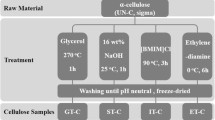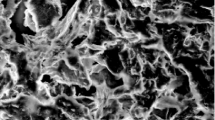The reprecipitation of cellulose from alkaline solutions was studied. The influence of the following factors on cellulose specific surface area was investigated: temperature, precipitant concentration, cellulose concentration in a stock alkaline solution, rate of precipitation, and presence of polyethylene glycol. After considering the results of regression analysis, the effects of different parameters on cellulose specific surface area were determined. The ratio of crystalline and amorphous phases in cellulose before and after reprecipitation was determined by XRD analysis.
Similar content being viewed by others
Explore related subjects
Discover the latest articles, news and stories from top researchers in related subjects.Avoid common mistakes on your manuscript.
Cellulose is the most common and promising organic raw material for producing alternative fuels and biodegradable composite materials. It is one of the universal structure-forming components of plant biomass, found in wood, cotton, rice husks, sunflower husks, and also synthesized by algae and some bacteria [1, 2]. In natural objects, cellulose is represented in the form of lignocellulose – a natural composite of cellulose, hemicellulose, and lignin [3, 4]. Direct conversion of lignocellulosic feedstock to ethanol is possible, however, as a rule, does not provide a high yield of the target product [5, 6]. To improve the processing efficiency of cellulose-containing raw materials, it is necessary to pre-process it, for example, by dissolving it in ionic liquids [7] or in mixtures of dimethylsulfoxide with organic bases [8], followed by precipitation. However, such solvents are too expensive for industrial implementation in pre-treatment.
The focus of the present work is a study of reprecipitation of cellulose from aqueous-alkaline solutions – an attractive perspective process due to low cost of the reagents. The specific cellulose surface area (m2/g) was selected as the response function. The factors that affect this function can be controlled during the reprecipitation process: reprecipitation temperature, precipitant concentration, cellulose concentration in the initial alkaline solution, reprecipitation rate, and the presence of polyethylene glycol, which is used as a stabilizer of the alkaline cellulose solution at room temperature [9].
Dissolution of cellulose was carried out as follows. Nine samples of microcrystalline cellulose (MCC) Avicel PH-101 (FMC Corp., Great Britain) in an amount of 1 g were mixed with 50 mL of 9% sodium hydroxide solution (Khimmed, Russia). Additionally, 0.5 g of PEG-4000 was added to the other 9 samples. The resulting slurries were cooled to –15 °C and held at this temperature for 12 hours, and then left to thaw at room temperature. After defrosting, the mixture was vigorously stirred until a homogeneous cellulose solution was obtained.
Cellulose regeneration was carried out by adding 110 mL of 1M hydrochloric acid to a cooled suspension (Khimmed, Russia).
The resulting samples without PEG were washed 5 times with distilled water and centrifuged at 8000 g. Samples reprecipitated in the presence of PEG were washed 8 times, and then were also centrifuged at 8000 g. After washing and centrifugation, the resulting samples were freeze-dried for 2 days.
Determination of the specific surface area of the samples by the BET method [10] was carried out by physical adsorption of N2 using a Micromeritics Gemini VII 2390 device using the standard procedure. The samples were degassed under vacuum at 50 °C for 3 hours to a pressure of 50 mTorr. The nitrogen adsorptiondesorption isotherm was recorded at 77 K. The specific surface area was determined through the BET theory in the range of relative pressures P/P 0 = 0.05 – 0.30.
The degree of crystallinity of cellulose was determined by X-ray powder diffraction using a Bruker D2 Phaser diffractometer equipped with the Diffrac.Suite software.
Regression analysis was performed using an orthogonal second-order central plan to determine the degree of influence of various factors on the specific surface area of cellulose upon reprecipitation from the aqueous-alkaline solution [11]. Among the variable factors, the temperature and rate of reprecipitation were chosen. The reprecipitation of cellulose from an aqueous-alkaline solution was carried out both in the presence of PEG and without it. Based on the experimental data obtained, the coefficients of the regression equation were calculated, after which the significance of the calculated coefficients was estimated.
X-ray analysis yielded information on the ratios of the crystalline and amorphous phases in the cellulose samples.
Fig. 1a shows a diffractogram of microcrystalline cellulose Avicel PH-101 before its dissolution in the water-alkaline solution.
The curve in the diffractogram shown under the “peak-riders,” the characteristic reflections of the (110) and (200) planes of crystalline cellulose, describes the peak of amorphous cellulose. It is known that when cellulose is dissolved in an aqueous-alkaline solution (mercerization process), a structural transition occurs from modification I to modification II, the difference between which is identified by X-ray diffraction analysis. Fig. 1b shows examples of cellulose diffractograms after its reprecipitation. One of the confirmations of the structural transition is a decrease in the intensity of the peaks 002 and 011, as well as a noticeable increase in the amorphous component, which indicates a disordering of the system.
Table 1 presents data on the content of the crystalline phase in cellulose samples reprecipitated under various conditions.
The samples reprecipitated in conditions of increased temperature and low rate of addition of the precipitant are particularly interesting due to the presence of new reflections responsible for the admixture of NaCl in the sample. Perhaps the reprecipitation of cellulose in this mode lead to the formation of a spatial structure containing closed or very narrow pores, from which the diffusion of salts is complicated.
In the case when the cellulose was reprecipitated in the presence of PEG, the temperature and the speed of the process exhibit a lesser effect on the structural modification of cellulose, in particular, on its ordering and the presence of defects. The maximum proportion of the crystalline phase is observed in the sample obtained in the regime of maximum rate of precipitation and maximum process temperature. The sample with the smallest amount of crystalline phase was obtained at room temperature and the maximum rate of precipitation.
The degree of crystallinity increased with a decrease in the rate of reprecipitation of the samples at 0 and 25 °C, whereas at 50 °C a decrease in the degree of crystallinity was evident, probably due to the filling of cellulose pores with sodium chloride not removed after completion of the precipitation.
The presence of PEG in the water-alkaline solution exerts a noticeable stabilizing effect on the system. Thus, the percentage of the crystalline phase varied in a smaller range of values. The degree of crystallinity decreased with increasing deposition time and temperature.
The analysis of data using the BET method made it possible to estimate how the area of the accessible surface varied as a function of the reprecipitation regime. The maximum surface area was observed for the sample deposited at the center of the experimental design – at room temperature and the average reprecipitation rate.
Unfortunately, the BET method can not be used to measure the specific area of cellulose reprecipitated in the presence of PEG. This is due to the fact that PEG sorbs on cellulose irreversibly, changing its adsorption properties, which makes it impossible to adequately interpret the data obtained during measurements. For samples of reprecipitated cellulose, a two-factor regression analysis was performed using an orthogonal second-order plan (Table 2). A linear transformation of the quadratic coefficients of the compositional plan was carried out to construct an orthogonal matrix, based on which the experiment was performed.
The obtained regression equation has the form:
The influence of the various factors on the specific surface area of cellulose was determined from the coefficients of the regression equation. Thus, the surface area was more influenced by the precipitation time than the temperature. In turn, the temperature and time had a slight influence on each other.
Thus, it has been found that the optimal conditions for the reprecipitation of cellulose, providing a material with reduced crystallinity and the maximum specific surface area of the available surface, are 25 °C at a precipitation time of 15 min. The developed mathematical model of reprecipitation of cellulose from wateralkaline solutions without PEG allows one to determine the optimal conditions for the process.
References
F. Jahan, V. Kumar, G. Rawat, et al., Appl. Biochem. Biotech., 167, No. 5, 1157–1171 (2012).
I. M. Saxena and R. M. Brown, Biosynthesis of Bacterial Cellulose. Bacterial Nanocellulose: A Sophisticated Multifunctional Material, ISBN 9781138073166, (2012) p. 1-18.
T. Nishino, I. Matsuda, and K. Hirao, Macromolecules, 37, No. 20, 7683–7687 (2004).
Y. Zhang, T. R. Brown, G. Hu, et al., Bioresource Technol., 127, 358–365 (2013).
N. R. Al’myasheva, A. A. Novikov, E. Yu. Kozhevnikova, et al., Chem. Tech. Fuels Oil., 51, No. 5, 516–525 (2015).
E. Yu. Kozhevnikova, D. A. Petrova, A. A. Novikov, et al., Appl. Biochem. Micro., 53, No. 5, 557–561 (2017).
D. A. Sharipova, Ya. A. Masyutin, A. A. Novikov, et al., Bashkir Khim. Zh., 19, No. 4, 156-159 (2012).
J. Wang, Z. Xue, C. Yan, et al., Phys. Chem. Ch. Ph., 18, No. 48, 32772–32779 (2016).
L. Yan and Z. Gao, Cellulose, 15, No. 6, 789–796 (2008).
S. Brunauer et al., J. Am. Chem. Soc., 60, No. 2, 309–319 (1938).
S. L. Akhnazarova and V. V. Kafarov, Methods of Experiment Optimization in Chemical Technology. Textbook [in Russian], Vysshaya Shkola, Moscow (1985).
The authors are grateful to D. A. Bakulin for conducting X-ray diffraction experiments. The research was carried out within the framework of the Federal Target Program “Research and Development in Priority Areas for the Development of the Russian Science and Technology Complex for 2014-2020” with the financial support of the Ministry of Education and Science of the Russian Federation (project 14.577.21.0235, unique identifier: Applied Research and Experimental Development RFMEFI57716X0235).
Author information
Authors and Affiliations
Corresponding author
Additional information
Translated from Khimiya i Tekhnologiya Topliv i Masel, No. 5, pp. 57-59, September-October, 2017.
Rights and permissions
About this article
Cite this article
Kotelev, M.S., Bobyleva, Z.V., Tiunov, I.A. et al. Investigation of the Influence of Conditions of Reprecipitation of Cellulose on its Adsorption Properties. Chem Technol Fuels Oils 53, 722–726 (2017). https://doi.org/10.1007/s10553-017-0854-y
Published:
Issue Date:
DOI: https://doi.org/10.1007/s10553-017-0854-y





